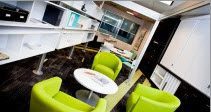Increasingly, organizations are asking ET Group about the importance of designing office space solutions that incorporates both the workspace and technology connection requirements of workers to accommodate personal and group meeting spaces in a variety of situations. More and more organizations are commenting that the old office cubicle farms just don’t cut it anymore. People need to be freed up to be able to work as easily in the cafeteria, a formal meeting space, their personal work space, or anywhere.
The ET Group and partner Mayhew & Associates, had the opportunity to demonstrate this new reality recently when we participated in Cisco’s annual customer event and showcase at the Toronto Congress Centre on May 16, 2012. The Toronto event is the largest of the Cisco Plus Canada Roadshow and attracted over 2000 technical and business decision-makers and influencers along with Cisco channel partners.
ET Group and Mayhew featured a booth in the Technology Showcase which combined purpose built, technology-enabled furniture along with video conferencing and white-boarding technology to simulate today’s office collaboration enhancing environments.
Why Cubicles Just Don’t Cut It.
- Furniture needs to be practical & functional for formal meetings as well as inviting and comfortable for impromptu gatherings.
- Space needs to be technology enabled to integrate naturally and quickly with technology solutions that connect users to their device of choice and then to connect over the internet with other workers wherever they are…seamlessly and quickly as a natural extension of the workers collaboration toolset.
- Collaboration technologies integrated into the space design and furniture need to provide an active workspace that immediately enables users to access their information, share it easily and robustly with others, whether they share the physical space or are connected virtually.
The resulting conversations of visitors at the show included concerns about the old style cube farms. People were enlightened to see that there are options out there for organizations who want to use space, furniture and technology to enhance the collaboration and productivity of the workforce.
One CEO at the show concurred with the negative impact of the “cube farm” and noted his particular challenge as a government funded organization, is that he can’t provide financial incentives to his staff, so providing an environment that is unique and the opposite of cubicle drudgery is what will attract and retain employees.
Other attendees noted that when you have the responsibility for representing many offices nationally, the need for creating collaborative environments cannot simply be addressed by adding technology or by re-configuring the office cubicle. Many companies struggle to understand the future of workspace in a holistic way.
Closing Thoughts on Cubicle Farms…
 Many companies think that moving past the cube farm is expensive, time consuming and disruptive to their business but they are not seeing the big picture. Employees are not only asking for integrated design space, furniture and technology, but it is a key driver of change management strategies required to assist people in their transition to working in different, collaborative ways. Companies need to invest beyond the cube farm and provide integrated workspaces that allow all types of workers to connect and enjoy their work environments.
Many companies think that moving past the cube farm is expensive, time consuming and disruptive to their business but they are not seeing the big picture. Employees are not only asking for integrated design space, furniture and technology, but it is a key driver of change management strategies required to assist people in their transition to working in different, collaborative ways. Companies need to invest beyond the cube farm and provide integrated workspaces that allow all types of workers to connect and enjoy their work environments.
The world is rapidly changing and we have to adapt just as quickly. Our customers are looking for leadership in helping them think about and design the collaboration ecosystems that will take them successfully into the future. Unfortunately, or fortunately, the traditional office cubicle, will likely only be found in a museum, if you have any questions about our mission or our team feel free to contact us.

